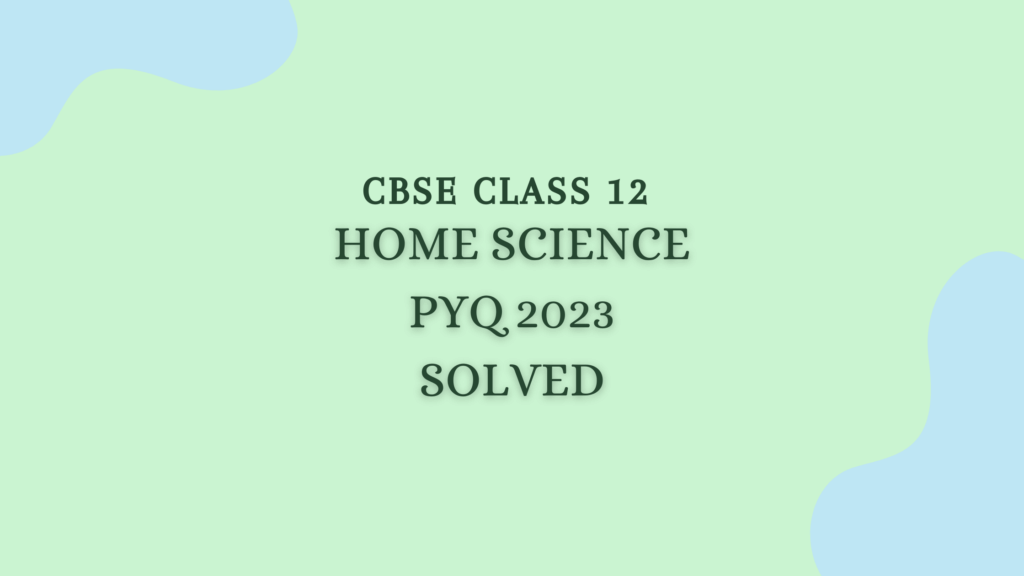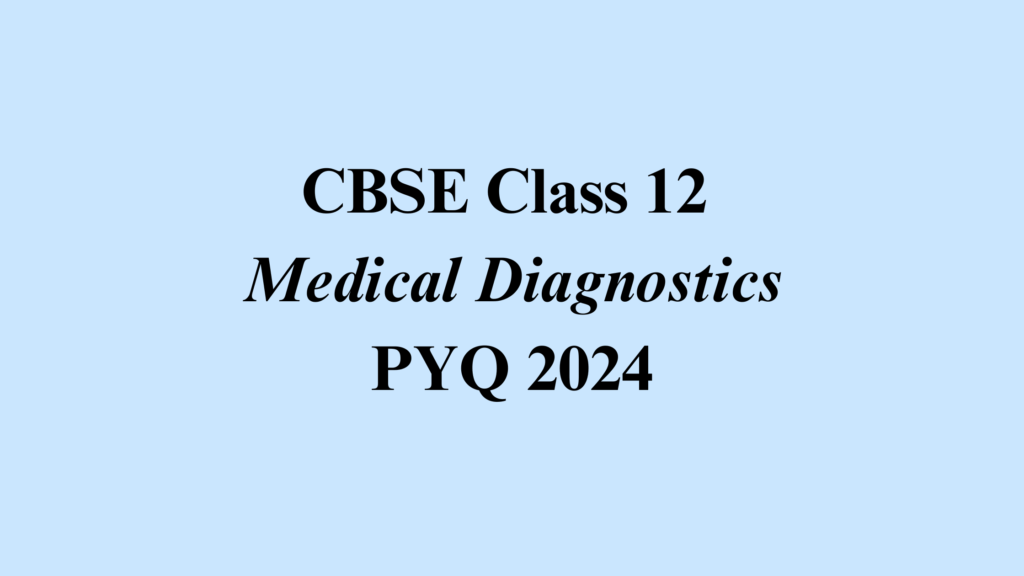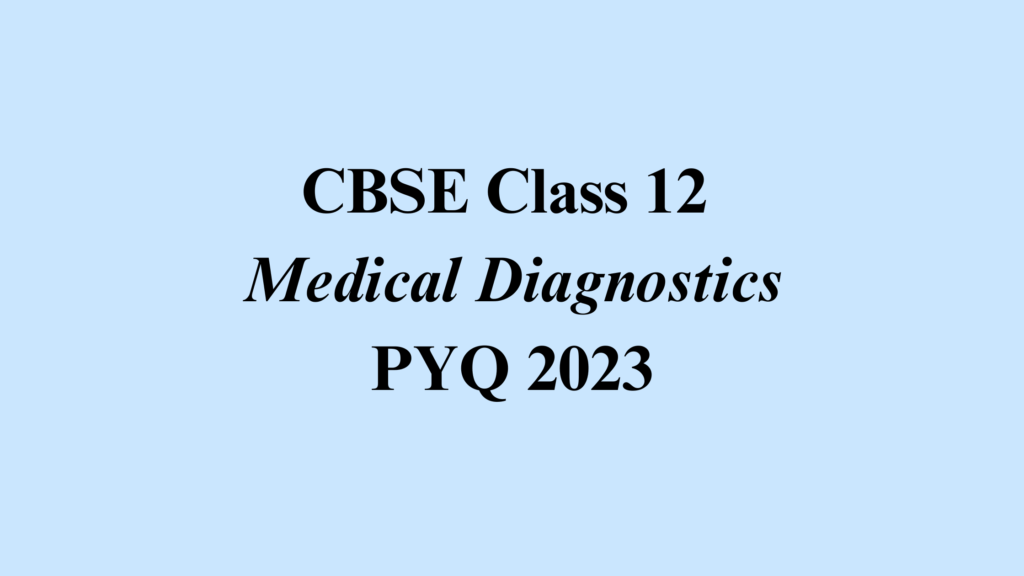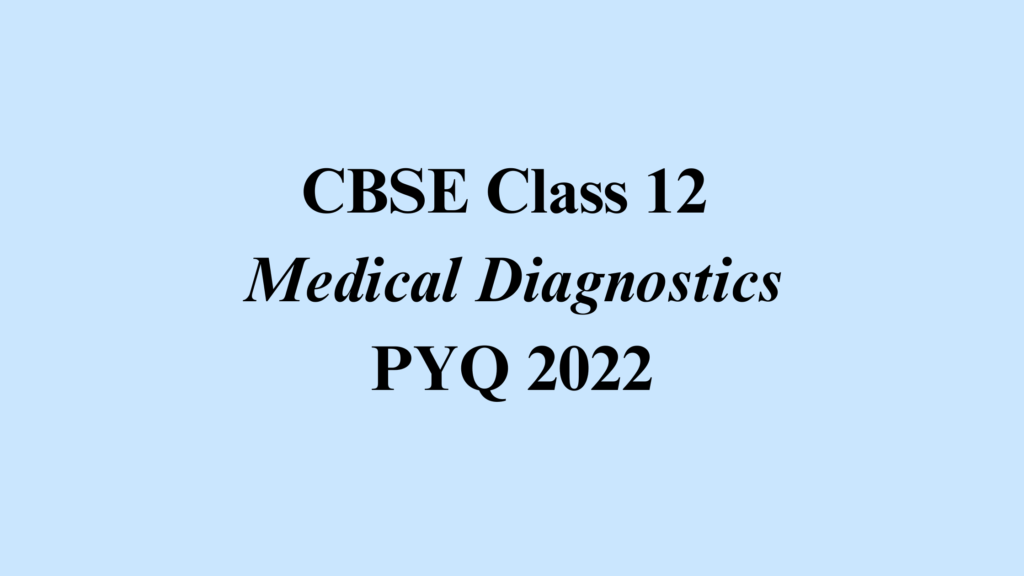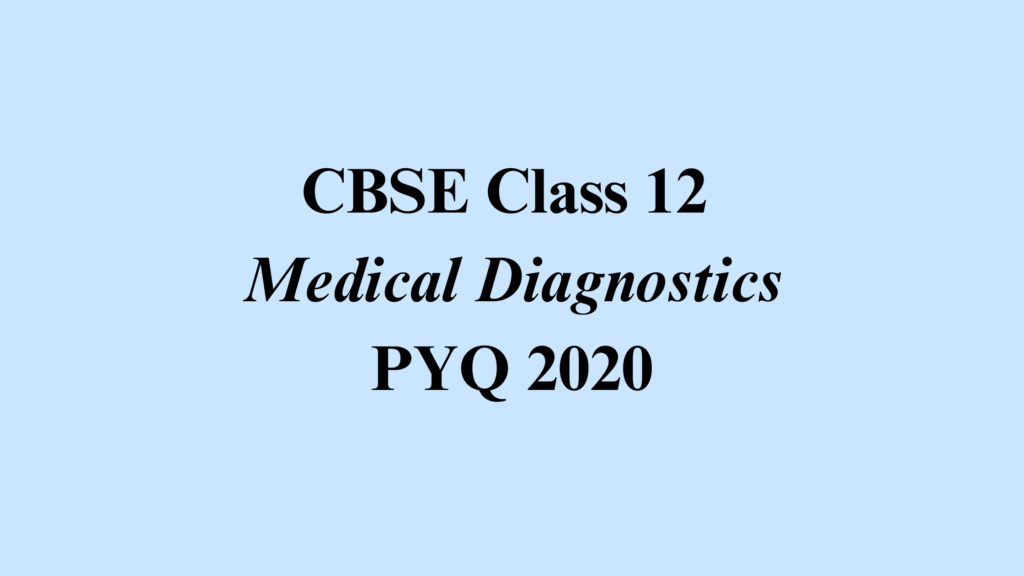Section A
1. Implementation of Red Ribbon Express (RRE) project was not supported by which of the following? 1
- (a) UNICEF
- (b) UNESCO
- (c) NYKS
- (d) NACO
2. Women cells have been created in Ministry of __________ to look at the problems of women workers. 1
- (a) Education
- (b) Home Affairs
- (c) Women and Child Development
- (d) Labour and Employment
3. _________ provides hospitality to people who go hiking, undertake adventure sports, etc. 1
- (a) Lodge
- (b) Resort
- (c) Furnished camp
- (d) Motel
4. Ayesha is running a campaign on irl Safety or effective communication, she has to prepare a short film for which knowledge of camera techniques and video production is required. Identify the skill needed to operate camera equipment correctly from the following: 1
- (a) Creative skills
- (b) Cognitive skills
- (c) Technical skills
- (d) Language and computer skills
5. Name the colour harmony/scheme where only neutral colours are used. 1
- (a) Split Complementary
- (b) Monochromatic
- (c) Achromatic
- (d) Triadic
6. Identify the handicraft in the given picture and name the State where it is popular. 1
- (a) Punjab
- (b) Uttar Pradesh
- (c) Rajasthan
- (d) Goa
Ans: Shola craft, Odisha or West Bengal (Option not provided)
7. Your mother wants to purchase silver bangles. Which standardization mark should she look for in them? 1
- (a) FSSAI
- (b) Hallmark
- (c) Woolmark
- (d) ISI
8. Abilities that enable people to behave in healthy ways, particularly in situations that challenge them are known as: 1
- (a) Attitudes
- (b) Life skills
- (c) Values
- (d) Physical labour
9. Match the following: 1
| i. National Youth Policy | 1. 2014 |
| ii. First SOS Children Village | 2. 2005 |
| iii. National Curriculum Framework | 3. 1964 |
| iv. National Policy for Older Persons | 4. 1999 |
Choose the correct option :
- (a) i 4, ii 3, iii 2, iv 1
- (b) i 3, ii 4, iii 1, iv 2
- (c) i 1, ii 3, iii 2, iv 4
- (d) i 3, ii 1, iii 4, iv 2
10. Match the following: 1
| 3. Chef de partie | 1. Receptionist |
| ii. Front Office | 2. Accountant |
| iii. Housekeeping department | 3. Chef-de-partie |
| iv. Support service department | 4. Room attendant |
Choose the correct option :
- (a) i 3, ii 1, iii 4, iv 2
- (b) i 1, ii 2, iii 3, iv 4
- (c) i 2, ii 3, iii 1, iv 4
- (d) i 3, ii 4, iii 2, iv 1
11. Identify the methods of washing clothes in a top-loading washing machine. 1
- (i) Research Scholar
- (ii) Tumbling
- (iii) Calendering
- (iv) Pulsation
Choose the correct option :
- (a) (i) and (ii)
- (b) (i) and (iv)
- (c) (ii) and (iv)
- (d) (ii) and (iii)
12. Raghav wants to pursue a career in the field of Development Communication. Which of the following options may he choose ? 1
- (i) Research Scholar
- (ii) Radio Jockey
- (iii) T.V. Anchor
- (iv) Visual Merchandiser
Choose the correct option :
- (a) (i), (ii) and (iv)
- (b) (i), (iii) and (iv)
- (c) (ii), (iii) and (iv)
- (d) (i), (ii) and (iii)
13. Proportion of Golden Mean with respect to garment size is represented by the following ratios: 1
- (i) 1: 2: 4
- (ii) 2: 4: 10
- (iii) 5: 8: 13
- (iv) 3: 5: 8
Choose the correct option :
- (a) (i) and (ii)
- (b) (iii) and (iv)
- (c) (i) and (iii)
- (d) (ii) and (iv)
Case Study-Based Questions
Read the passage carefully and answer the questions no. 14 to 18.
Public Health Nutrition is the field of study that is concerned with promotion of good health through prevention of nutrition related illnesses/problems in the population and the government policies and programmes that are aimed at solving these problems. Public Health nutritionists/professionals use large scale, organised and multidisciplinary approaches to solve the problems that affect the population, i.e., large number of people for whom group action is necessary. Therefore, this field is multidisciplinary in nature and is built on the foundation of biological and social sciences. It differs from other fields of nutrition, e.g. clinical nutrition and dietetics, because the professionals are required to address problems of community/public, specially the vulnerable groups.
14. Micronutrient deficiency is called _________. 1
- (a) Goitre
- (b) Anemia
- (c) Hidden hunger
- (d) Obesity
15. Professionals who deal with nutritional management of illness of an individual are referred to as: 1
- (i) Clinical Nutritionist
- (ii) Public Health Nutritionist
- (iii) Medical Representative
- (iv) Medical Nutrition Therapist
- (v) Dietitian
Choose the correct option :
- (a) (i), (ii), (iii)
- (b) (i), (iii), (iv)
- (c) (i), (iii), (v)
- (d) (i), (iv), (v)
16. Which of the following condition results when an individual’s body weight is less than adequate weight for his/her age? 1
- (a) Overweight
- (b) Underweight
- (c) Wasting
- (d) Stunting
17. What is Public Health Nutrition concerned with ? 1
- (i) Promotion of good health at individual level
- (ii) Promotion of good health at population level
- (iii) Prevention of individual nutrition-related illnesses/problems
- (iv) Prevention of community-related nutritional illnesses/problems
- (v) Planning and implementing strategies for holistic nutrition
Choose the correct option :
- (a) (i), (iii), (iv)
- (b) (ii), (iii), (v)
- (c) (i), (ii), (iv)
- (d) (ii), (iv), (v)
18. Which of the following is not an example of tertiary health care? 1
- (a) All India Institute of Medical Sciences
- (b) Primary Health Centre
- (c) Medical College Hospital
- (d) Specialised Hospitals
Section B
19. Within the board category ‘Youth’, write names of four groups who are especially vulnerable. 2
Ans: Names of four Youth groups who are especially vulnerable-
- 1. Rural and Tribal Youth
- 2. Out-of-school Youth
- 3. Adolescents, particularly female adolescents
- 4. Youth with disabilities
- 5. Youth under especially difficult circumstances, like victims of trafficking, orphans and street children
20. How are phytochemicals different from medical foods ? 2
Ans: Phytochemicals (Bioactive compounds): They are non-nutrient constituents present in foods that have physiological or biological activity and influence health.
Medical foods: They are those products that are specially manufactured for persons with specific needs. Such foods are regulated and can be used only with a doctor’s prescription for the specific dietary management of a disease or condition. Example-Lactose free milk, low-sodium salt, etc.
21. (a) List four pillars on which the science of ergonomics is set. 2
Ans: Four pillars of ergonomics-
- 1. Anthropometry (body size and measurements)
- 2. Biomechanics (musculoskeletal activities and forces exerted)
- 3. Physiology
- 4. Industrial psychology
OR
(b) Why are social entrepreneurs called ‘social catalysts’. Write any two characteristics of an entrepreneur. 2
Ans: Social entrepreneurs are called ‘social catalysts’ as they-
- 1. Focus on social good
- 2. achieve large-scale social benefits
- 3. Work for the under served/neglected/ disadvantaged people
- 4. Help those who lack financial resources
- 5. create/bring social changes
- 6. Bring sustainable development /improvements
- 7. bring development in social fields of education/health care/economic development /environment/arts/any other
- 8. does not work for profits but for social benefits and impact
Two characteristics of an entrepreneur-
- 1. Willingness to work hard
- 2. Knowledge and skills for planning and implementation
- 3. Skills of management of finances, materials, personnel and time
- 4. Having the courage to take calculated risks
- 5. Ability and preparedness to handle many tasks simultaneously
- 6. Ability to learn and acquire the necessary skills for the tasks at hand
- 7. Ability to deal with tough issues and find solutions
- 8. Being realistic and not expecting easy solutions
- 9. Ability to cope with setbacks, challenges and failures
- 10. Ability to develop partnerships, and able to network
- 11. Ability to negotiate, strategise and prioritise
- 12. Being flexible and able to handle crises
- 13. Have good communication skills
22. (a) Enlist any four objectives of Diet Therapy. 2
Ans: Four objectives of Diet Therapy are-
- 1. Formulation of the diet to meet the needs of the patient, taking into consideration her or his food habits
- 2. Modification of the existing diets to ameliorate the disease condition and to keep it under control
- 3. Correction of nutritional deficiencies
- 4. Prevention of short-term and long-term complications in case of chronic diseases
- 5. Education and counselling of the patient regarding the need to adhere to the prescribed diet
OR
(b) Which four methods are used by a dietitian/clinical nutritionist to assess the nutritional status of a patient ? 2
Ans: Four methods used by a dietitian/clinical nutritionist to assess the nutritional status of a patient-
- 1. Obtaining detailed information on health, diet, personal and medication histories/Clinical assessment
- 2. Anthropometric measurements (Height, weight, head and chest circumference)
- 3. Relating the information on laboratory tests and physical measurements with the above and the physician’s diagnosis/Biochemical assessment
- 4. Interpreting all of the above to identify potential nutritional deficiencies and risk of future deficiencies/Disease Identification
23. (a) What do you understand by the term “Community Radio”?
(b) Describe its two important roles in the development of the country. 2
Ans: Community radio is/has –
- 1. An initiative of the Ministry of Information and Broadcasting
- 2. Also known as local radio
- 3. by the community, for the community and about the community
- 4. interactive format
- 5. run and managed by local people/ usually trained by NGO
- 6. people’s medium
- 7. used for the local community/people
- 8. local dialect/language
- 9. Participatory content development
- 10. Set up with a small investment
- 11. not for profit
- 12. used for broadcasting in limited areas
It’s two important roles –
- 1. Support local programmes of development
- 2. give opportunity to participate and express their views/become the voice of the people
- 3. Promote social change
- 4. give opportunity to display their talents
- 5. catalyst for people’s development
- 6. Develop career/create employment opportunities in DCJ
- 7. help communities in voicing their problems and finding solutions (Any other, Any two)
24. (a) Differentiate between manufactured foods and formulated foods. Give one example each. 2
Ans:
| Manufactured foods | Formulated foods |
| These are products prepared by mixing and processing of individual ingredients to result in relatively shelf-stable food products. | These are products prepared by mixing and processing individual ingredients to result in relatively shelf-stable food products. |
| Examples- pickles, jams, marmalades, squashes, papads, wadis. | Examples- bread, biscuits, ice cream,cakes, kulfi. |
OR
(b) (i) What do you understand by High Risk Foods? Give one example.
(ii) Which temperature range is called the Danger Zone for growing of bacteria ? 2
Ans: High-Risk Foods: They are protein-rich foods attacked by bacteria. Example- Meat, fish, poultry, eggs and dairy products (Any other, Any one example)
(ii) Temperature range- 5-6 °C
25. France’s dominance over international fashion began in the early 18th century. Mention any two developments in fashion until the Industrial Revolution. 2
Ans: Development in fashion until the Industrial Revolution-
- 1. Support from the royal court
- 2. Development of silk industries in France
- 3. Many of the French cities were supplying the court with silk fabrics, ribbons and laces
- 4. Clothes were handmade / hand-sewn
- 5. Clothes were custom-made
26. (a) As per National Curriculum Framework (NCF) publication on ECCE, enlist any six guiding principles of ECCE. 3
Ans: Six guiding principles of ECCE-
- 1. Play as the basis for learning
- 2. Art as the basis of education
- 3. Recognition of the special features of children’s thinking
- 4. Primacy of experience rather than expertise (i.e., experiential learning is emphasised)
- 5. Experience of familiarity and challenge in everyday routines
- 6. Mix of formal and informal interactions
- 7. Blend of textual and cultural sources
- 8. Use of local materials, art and knowledge
- 9. Developmentally appropriate practices, flexibility and plurality
- 10. Health, well-being and healthy habits
OR
(b) Fatima Bano wants to send her three-year-old child to a preschool. Explain to her the six attributes that she should look for in a good preschool. 3
Ans: Six attributes that she should look for in a good preschool-
- 1. Safe and secure environment
- 2. Clean and hygienic environment
- 3. Playway method of learning
- 4. Child-centred approach
- 5. First Aid / Medical Facilities
- 6. Loving and Trained teachers/staff
- 7. Variety of play materials / Recreational Facilities
- 8. Informal education
- 9. Optimal learning environment
- 10. Prepares for formal school
- 11. Availability of additional support for children with special needs or difficult circumstances/ Inclusive education
27. Mandeep wants to buy a readymade pants and shirt. Explain two ways by which he can bring harmony in it.
Ans: Two ways by which harmony can be created-
- 1. By texture-Texture and accessories should be in accordance with each other. For perfect harmony, both the shirt and pants should be of the same texture. Example-Cotton shirt with cotton pants.
- 2. By shape- By using the same lines and shapes in a garment, by matching prints, angles of lines and colours to maintain the continuity of the design. Example- Collar, cuff, pocket and hem should be of the same shape.
- 3. By colour- Using any colour scheme/harmony. Example-Colour of both the shirt and the pants should blend together according to any colour scheme.
28. Julia wants to set up her own small hotel.
(a) She wants to make her employees understand the Guest cycle first. Explain the four stages of guest cycle for her employees.
(b) List two environmental conservation and eco-friendly practices which she will ensure in her hotel. 3
Ans: Four stages of the guest cycle-
- 1. Pre-arrival Stage -quoting rates for a guest, reserving a room.
- 2. Arrival Stage- The guest actually arrives and registers or checks in.
- 3. Occupancy Stage -providing services as per the guest’s requirements, ensuring security of the guest, coordinating various guest services, and ensuring guest satisfaction.
- 4. Departure Stage -This is the final stage where the guest is ready to leave/ move out or check out of the accommodation. Guest history, including feedback from the guest, is obtained.
(b) List two environmental conservation and eco-friendly practices which she will ensure in her hotel. Two environmental conservation and eco-friendly practices to be ensured in the hotel-
- 1. Using 100 per cent organic cotton bed sheets
- 2. Using chemical-free laundry cycle
- 3. using agents which are non-toxic, water-based, hypoallergenic and biodegradable
- 4. Urging the guest to reuse towels so that resources like water, electricity, and detergent used for laundering can be saved
- 5. Use of energy-efficient light bulbs in rooms can help save electricity
- 6. Rainwater harvesting
- 7. Use of solar energy
- 8. Avoid single-use plastic
- 9. plantation of trees/maintaining hotel lawns
- 10. Composting from the hotel’s kitchen waste
29. Give full forms of the following international organisations dealing with food standards, quality and trade. 3
- (a) CAC
- (b) ISO
- (c) WTO
Ans: Full forms –
- (a) CAC- Codex Alimentarius Commission
- (b) ISO-International Organisation for Standardisation
- (c) WTO-World Trade Organisation
Section C
30. (a) You have to give a speech on ‘National Consumers Day’ in your school. Mention which four consumer rights and four consumer responsibilities you will incorporate in your speech. 2+2=4
Ans: Four consumer rights-
- 1. Right to Safety
- 2. Right to Choose
- 3. Right to be Informed
- 4. Right to be Heard
- 5. Right to seek Redressal
- 6. Right to Consumer Education (Any four)
Four consumer responsibilities-
Consumer should-
- 1. Regularly update their knowledge of various laws made by the government.
- 2. Be honest in all their dealings and must pay for all their purchases.
- 3. Do a market survey and compare the prices.
- 4. Feel free to choose from a variety available as per their needs and requirements.
- 5. Read all the information given on the label/ brochure.
- 6. Buy products with standardisation marks.
- 7. Keep receipts and other relevant documents of purchase.
- 8. Read and understand all terms and conditions, liabilities, service charges, etc., before purchasing services like insurance, credit cards, bank deposits, etc.
- 9. Have increased awareness about various national and international consumer organisations. (Any other, Any four)
OR
(b) (i) Prakash is working in a semi-government consumer organization. State four important roles his organization should be performing in the interest of consumers.
(ii) Name any one consumer organization based each in Delhi and Ahmedabad. Also name the magazines which they publish. 2+2=4
Ans: Four important roles of consumer organisations-
- 1. Creating consumer awareness
- 2. Disseminating information through magazines, booklets, newsletters, buying guides, audiovisual material, etc.
- 3. Providing legal advice
- 4. Comparative testing of products
- 5. Conducting a product recall
- 6. Handling Consumer complaints and grievances
- 7. Organising public meetings
- 8. Empowering consumers and the consumer movement
- 9. Bringing out publications in Consumer interests
- 10. Setting up of libraries and documentation centres
- 11. Act as a vigilance group (Any other, Any four)
(ii) Name any one consumer organization based in Delhi and Ahmedabad. Also name the magazines which they publish.
| Place | Consumer Organization | Magazine |
| Delhi | VOICE | Consumer Voice |
| Ahmedabad | CERC | Insight |
31. (a) (i) Enlist any two short-term interventions of POSHAN Abhiyaan which was launched in March 2018.
(ii) Mention any four nutritional programmes operating in our country, other than POSHAN Abhiyan. 2+2=4
Ans: (i) Two short-term interventions of POSHAN Abhiyaan-
- 1. Integrated Child Development Services (ICDS) to cover all vulnerable children in the age group of 0-6 years and all pregnant and lactating mothers
- 2. Fortification of essential foods (salt fortified with iodine)
- 3. Production and popularisation of low-cost nutritious foods from indigenous and locally available raw materials by involving women in this activity
- 4. Control of micronutrient deficiencies among vulnerable groups by supplementing these nutrients, distributing free tablets, etc. (Any two)
(ii) Four nutritional programmes operating in our country other than Poshan Abhiyaan-
- 1. ICDS
- 2. Nutrient Deficiency Control programmes-
- National Prophylaxis Programme for Prevention of Blindness due to Vitamin A Deficiency
- National Nutritional Anaemia Prophylaxis Programme
- National Iodine Deficiency Disorder Control Programme
- 3. Food Supplementation Programmes-
- Mid-Day Meal Programme
- 4. Food Security Programmes-
- Public Distribution System
- Antodaya Anna Yojana
- Annapurna Scheme
- National Food for Work Programme
- 5. Self-employment and wage employment schemes (Any other, Any four)
OR
(b) (i) What do you understand by modified diets?
(ii) Based on changes in consistency, what are the three types of diets? Give one example of each diet. 1+3=4
Ans: Modified diets are those that are adjusted to meet the medical needs of a patient or special requirements of an individual.
(ii) Three types of diets based on changes in consistency-
- 1. Clear liquid diet
- very thin in consistency
- given just after surgery
- Free from fibre and less in spices
Examples- Coconut water, clear soups/juices (without pulp), etc.
- 2. Liquid diet
- fluid in consistency at room temperature
- advised to people who are unable to chew or swallow
- Very less in fibre and spices
Example- Soup, fruit juice, milk, buttermilk, etc.
- 3. Semi-solid diet
- Includes food in semi-solid state
- less in fibre and spices
Example- Thin custard, thin porridge, etc.
- 4. Soft diet
- lightly seasoned and less fibrous
- easy to chew and digest
Examples-Khichdi, porridge, custard, dalia, etc.
- 5. Mechanical soft diet
- includes soft, mashed and pureed food
- advised for elderly/infants/persons with problems in chewing
- easily digestible – no harsh fibre, less oily and spicy
Example- Stewed fruits, mashed and boiled vegetables, etc. (Any three with one example for each)
32. (a) In fashion industry, what is the meaning of the term ‘Fads’? Give one example.
(b) Discuss the three levels of merchandising in fashion industry. 1+3=4
Ans: (a) Fads are short-lived fashions which can come and go in a single season. They lack the design strength to hold consumer attention for long. Example- Hot pants, baggy pants, unmatched buttons, etc. (Any other, Any one example)
(b) Three levels of merchandising in fashion industry-
- 1. Retail organization merchandising
- It is the business that moves the fashion world from the designer’s showroom to the retail sales floor and into the hands of consumers.
- Ensures that an adequate amount of merchandise is on hand and sold at prices that consumers are willing to pay.
- 2. Buying Agency Merchandising
- Acts as the procurement office for the buyers.
- Keeps regular control over quality during the production process.
- Provides services for buying consultancy.
- Profitable for exporters- saves cost and time.
- 3. Export House Merchandising
- Two types of merchandising in an export house –
- a) Buyer merchandiser-
- acts as a link between the buyer and the manufacturer.
- ensures the requirements of the buyer.
- b) Production merchandiser-
- acts as a link between production and buyer merchants.
- ensures that the production goes according to the schedule and requirements of the buyer. (Any one point for each level)
33. (a) Five-year-old Bunty is separated from his parents at the railway station. Which type of c home will the railway personnel send him to ?
(b) Briefly explain two other kinds of children homes run by the Government for vulnerable children.
(c) Name the law enacted for children involved in anti-social activities. 1+2+1=4
Ans: (a) Observation Home
(b) Two other kinds of children’s homes run by the Government for vulnerable children-
- 1. Special homes- where juveniles (children under 18 years of age) found guilty in terms of violation of law, are placed in custodial care.
- 2. Juvenile/Children’s homes- where children whose families are not traceable, or are unfit/ dead or simply unwilling to take the child back stay. The government is responsible for providing room, boarding, education and vocational training.
(c) Juvenile Justice (Care and Protection of Children) Act
34. (a) Which five knowledge and skills are required by a recipe development professional involved in the Food Processing and Technology industry ? Elaborate in detail. 5
Ans: Five knowledge and skills required by a recipe development professional involved in the Food Processing and Technology industry are-
- 1. Expertise in cooking
- 2. Knowledge of nature and properties of food
- 3. Uses of ingredients, measuring and weighing them accurately
- 4. Designing, analysing and adapting a basic recipe
- 5. Food handling skills
- 6. Food production following hygiene and safety norms
- 7. Handling tools and equipment accurately
- 8. Innovations in product design and preparation according to consumer perceptions
- 9. Use of Information Technology for contemporary production (Any other, Any five)
OR
(b) Define Toxicity and Hazard. Explain three types of hazards in foods with examples. 1+1+3=5
Ans: Toxicity: It is the capacity of a substance to produce harm or injury of any kind under any conditions.
Hazard: It is the relative probability that harm or injury will result when the substance is not used in a prescribed manner and quantity.
Three types of hazards in foods with examples –
- 1. Physical Hazard- Any physical material not normally found in food which causes illness or injury. Example- wood, stones, hair, bidi, cigarettes, buttons, nails, etc.
- 2. Chemical Hazard – Chemical or deleterious substances which may be intentionally or unintentionally added to foods. Example- pesticides, chemical residues, food colours, preservatives, toxic metals, etc.
- 3. Biological Hazards- Living organisms which include microbiological organisms associated with food, that cause diseases. They may be of two types –
- Visible-Example-worms, fly, cockroach, weevil, etc.
- Invisible-Example-bacteria, virus, yeast, mould,
35. (a) Your friend wants to become a fashion designer. Enumerate three primary skills that he should possess, in order to be successful.
(b) Illustrate and explain to him the difference between formal and informal balance. 3+2=5
Ans: (a) Apart from flair/ knowledge of fashion, three primary skills required to become a successful fashion designer are –
- 1. Forecasting ability/should be able to predict fashion trends/awareness of market trends
- 2. Analytical ability/must keep abreast of the economy/should understand how styles fit into the budget
- 3. Communication ability/should be able to negotiate with the manufacturer and sell their fashion choices to the consumer/ Writing skills (Any other, Any three)
(b)
| Formal Balance | Informal Balance |
| 1. It is a symmetrical balance. | It is an asymmetrical balance. |
| 2. Same on each side of a central vertical line. | Not the same on either side of a central vertical line. |
| 3. Tends to get monotonous | Does not get monotonous |
| 4. It is less expensive | It can be expensive |
| 5. It gives a feeling of stability and formality. | It is used to correct figure problems. |
Any other, Any one difference
CBSE Class 12 Home Science 2023 Solved Paper PDF
Clcik here to download the CBSE Class 12 Home Science 2024 Solved Paper.
